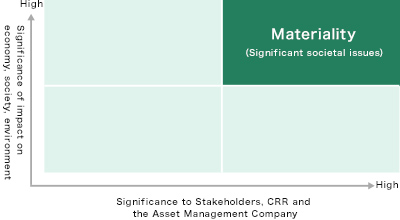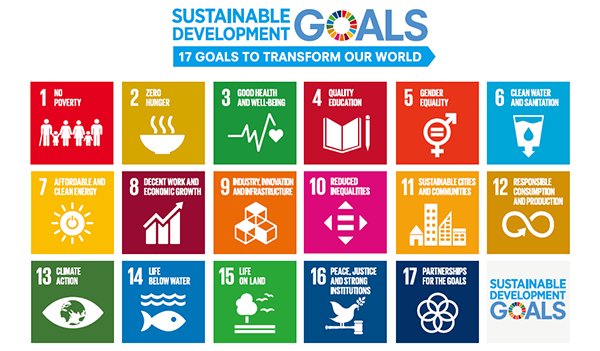Materiality
Identification process
Materiality was identified by select cross-divisional members of the Asset Management Company.

Awareness and organization of societal issues
In preparing discussions for Materiality, societal issues related to CRR and the Asset Management Company were extracted by referencing the Group Integrated Report; materiality; GRI Standards; relevant SDGs; ESG assessments for the real estate sector; and issues recognized by the industry association.

Integration and consolidation of issues
With respect to the above stated societal issues, a materiality short list was created after summarizing the tasks which CRR and the Asset Management Company has been working on, and discussing topics that should be given higher significance, with additional consideration to risks and opportunities regarding each issue.

Reflection of opinions from officers and employees
All officers and employees were asked to offer opinions as stakeholders of the Asset Management Company, and preliminary interview was conducted with executive officers and supervising directors of CRR.

Identification of materiality
Based on the interview results, significance of each issue to be addressed by CRR and the Asset Management Company was reviewed for appropriateness.
Materiality was identified by the Sustainability Promotion Council and reported to the board of directors of the Asset Management Company and CRR.

SDGs with close relevance to the Materiality
The Materiality, which is shared between CRR and the Asset Management Company, is identified by considering the impact from a view of risks and opportunities, and the significance for us to address.
Our aim is to contribute to the SDGs (Sustainable Development Goals) through our commitment to the Materiality.
| Materiality | Risks (Impact of not addressing materiality) |
Opportunities (Business opportunities expected by addressing materiality) |
Relevant SDGs |
|---|---|---|---|
| Reducing environmental impact | Increased physical risk from escalation of climate change (human damage, property damage, economic damage), risks associated with a transition to a decarbonized society |
• Share clear commitment to ESG investment with officers and employees, providing opportunity for implementation and incorporation in our business strategy • Increased demand for leasing properties focused on environmental performance |
|
| Human capital development as a group of professionals |
Failure to implement a human resources strategy that is based on respect for human rights and that takes into account the perspectives of diversity, equity, and inclusion, or lack of sufficient skilled resources may hinder business operation, leading to stagnant or lower investor values | Each employee’s effort to further realize their abilities and maintain mental health and stable living while fulfilling the fiduciary duty required of asset management business and working towards our goal of maximizing unitholder value and enhancing our presence, as we implement human capital management, will create a positive cycle and improve our performance | |
| Contribution to the region |
• Breakdown of communication with local community at times of emergency such as disaster may cause reputational risk • Risk of loss of liveliness due to the image of the invested region becoming obsolete or due to population decrease |
Show presence by contributing to the safety and security of the region and vitalization of local economy as a member of a corporate group committed to urban development | |
| Health and well-being of tenants | Facilities with inferior ESG considerations may risk losing support from tenants | Contract renewal and repeated selection for relocation by tenants can be expected by creating safe, comfortable and pleasant space for tenants | |
| Supplier engagement | Impact on management operation and deteriorated credit in case significant violation against sustainable procurement such as discrimination, exploitation, destruction of nature, contamination and violation of laws by suppliers are recognized | Collaborate with suppliers to make transactions that take into consideration human rights and satisfy fiduciary duty required of asset management business and contribute to becoming the REIT of choice by the investors | |
| Management framework corresponding to multifaceted social demand towards sustainable society | Inappropriate response to multifaceted social demands may risk fall in trust concerning sound and effective management business and affect market development | Enhanced commitment from the perspective of respecting human rights to environmental issues including climate change and social issues such as human capital management and supply chain management will further promote establishment of medium- to long-term business platform, and improvement in financial value can be expected |
Sustainable Development Goals (SDGs)
The United National Sustainable Development Summit was held from 25 to 27 September 2015 at the United Nations headquarters in New York with participation by leaders from more than 150 member countries, and adopted the resolution, “Transforming our world: the 2030 Agenda for Sustainable Development.” At the same time, a declaration and goals were announced as an action plan for people, planet and prosperity. They were the Sustainable Development Goals (SDGs) comprising of 17 goals and 169 targets.

